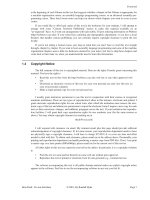Tài liệu The Art of Computer Virus Research and Defense pptx
Bạn đang xem bản rút gọn của tài liệu. Xem và tải ngay bản đầy đủ của tài liệu tại đây (7.71 MB, 3,014 trang )
THE ART OF COMPUTER
VIRUS RESEARCH AND
DEFENSE
Table of Contents
Copyright
About the Author
Preface
Who Should Read This Book
What I Cover
What I Do Not Cover
Acknowledgments
Contact Information
Part I: STRATEGIES OF THE
ATTACKER
Chapter 1. Introduction to the
Games of Nature
1.1. Early Models of Self-
Replicating Structures
1.2. Genesis of Computer
Viruses
1.3. Automated Replicating
Code: The Theory and
Definition of Computer Viruses
References
Chapter 2. The Fascination of
Malicious Code Analysis
2.1. Common Patterns of Virus
Research
2.2. Antivirus Defense
Development
2.3. Terminology of Malicious
Programs
2.4. Other Categories
2.5. Computer Malware
Naming Scheme
2.6. Annotated List of Officially
Recognized Platform Names
References
Chapter 3. Malicious Code
Environments
3.1. Computer Architecture
Dependency
3.2. CPU Dependency
3.3. Operating System
Dependency
3.4. Operating System Version
Dependency
3.5. File System Dependency
3.6. File Format Dependency
3.7. Interpreted Environment
Dependency
3.8. Vulnerability Dependency
3.9. Date and Time
Dependency
3.10. JIT Dependency:
Microsoft .NET Viruses
3.11. Archive Format
Dependency
3.12. File Format Dependency
Based on Extension
3.13. Network Protocol
Dependency
3.14. Source Code Dependency
3.15. Resource Dependency on
Mac and Palm Platforms
3.16. Host Size Dependency
3.17. Debugger Dependency
3.18. Compiler and Linker
Dependency
3.19. Device Translator Layer
Dependency
3.20. Embedded Object
Insertion Dependency
3.21. Self-Contained
Environment Dependency
3.22. Multipartite Viruses
3.23. Conclusion
References
Chapter 4. Classification of
Infection Strategies
4.1. Boot Viruses
4.2. File Infection Techniques
4.3. An In-Depth Look at
Win32 Viruses
4.4. Conclusion
References
Chapter 5. Classification of In-
Memory Strategies
5.1. Direct-Action Viruses
5.2. Memory-Resident Viruses
5.3. Temporary Memory-
Resident Viruses
5.4. Swapping Viruses
5.5. Viruses in Processes (in
User Mode)
5.6. Viruses in Kernel Mode
(Windows 9x/Me)
5.7. Viruses in Kernel Mode
(Windows NT/2000/XP)
5.8. In-Memory Injectors over
Networks
References
Chapter 6. Basic Self-
Protection Strategies
6.1. Tunneling Viruses
6.2. Armored Viruses
6.3. Aggressive Retroviruses
References
Chapter 7. Advanced Code
Evolution Techniques and
Computer Virus Generator Kits
7.1. Introduction
7.2. Evolution of Code
7.3. Encrypted Viruses
7.4. Oligomorphic Viruses
7.5. Polymorphic Viruses
7.6. Metamorphic Viruses
7.7. Virus Construction Kits
References
Chapter 8. Classification
According to Payload
8.1. No-Payload
8.2. Accidentally Destructive
Payload
8.3. Nondestructive Payload
8.4. Somewhat Destructive
Payload
8.5. Highly Destructive Payload
8.6. DoS (Denial of Service)
Attacks
8.7. Data Stealers: Making
Money with Viruses
8.8. Conclusion
References
Chapter 9. Strategies of
Computer Worms
9.1. Introduction
9.2. The Generic Structure of
Computer Worms
9.3. Target Locator
9.4. Infection Propagators
9.5. Common Worm Code
Transfer and Execution
Techniques
9.6. Update Strategies of
Computer Worms
9.7. Remote Control via
Signaling
9.8. Intentional and Accidental
Interactions
9.9. Wireless Mobile Worms
References
Chapter 10. Exploits,
Vulnerabilities, and Buffer
Overflow Attacks
10.1. Introduction
10.2. Background
10.3. Types of Vulnerabilities
10.4. Current and Previous
Threats
10.5. Summary
References
Part II: STRATEGIES OF THE
DEFENDER
Chapter 11. Antivirus Defense
Techniques
11.1. First-Generation Scanners
11.2. Second-Generation
Scanners
11.3. Algorithmic Scanning
Methods
11.4. Code Emulation
11.5. Metamorphic Virus
Detection Examples
11.6. Heuristic Analysis of 32-
Bit Windows Viruses
11.7. Heuristic Analysis Using
Neural Networks
11.8. Regular and Generic
Disinfection Methods
11.9. Inoculation
11.10. Access Control Systems
11.11. Integrity Checking
11.12. Behavior Blocking
11.13. Sand-Boxing
11.14. Conclusion
References
Chapter 12. Memory Scanning
and Disinfection
12.1. Introduction
12.2. The Windows NT Virtual
Memory System
12.3. Virtual Address Spaces
12.4. Memory Scanning in User
Mode
12.5. Memory Scanning and
Paging
12.6. Memory Disinfection
12.7. Memory Scanning in
Kernel Mode
12.8. Possible Attacks Against
Memory Scanning
12.9. Conclusion and Future
Work
References
Chapter 13. Worm-Blocking
Techniques and Host-Based
Intrusion Prevention
13.1. Introduction
13.2. Techniques to Block
Buffer Overflow Attacks
13.3. Worm-Blocking
Techniques
13.4. Possible Future Worm
Attacks
13.5. Conclusion
References
Chapter 14. Network-Level
Defense Strategies
14.1. Introduction
14.2. Using Router Access Lists
14.3. Firewall Protection
14.4. Network-Intrusion
Detection Systems
14.5. Honeypot Systems
14.6. Counterattacks
14.7. Early Warning Systems
14.8. Worm Behavior Patterns
on the Network
14.9. Conclusion
References
Chapter 15. Malicious Code
Analysis Techniques
15.1. Your Personal Virus
Analysis Laboratory
15.2. Information, Information,
Information
15.3. Dedicated Virus Analysis
on VMWARE
15.4. The Process of Computer
Virus Analysis
15.5. Maintaining a Malicious
Code Collection
15.6. Automated Analysis: The
Digital Immune System
References
Chapter 16. Conclusion
Further Reading
Index
index_SYMBOL
index_A
index_B
index_C
index_D
index_E
index_F
index_G
index_H
index_I
index_J
index_K
index_L
index_M
index_N
index_O
index_P
index_Q
index_R
index_S
index_T
index_U
index_V
index_W
index_X
index_Y
index_Z
THE ART OF COMPUTER VIRUS RESEARCH AND
DEFENSE
By Peter Szor
Publisher : Addison Wesley Professional
Pub Date : February 03, 2005
ISBN : 0-321-30454-3
Pages : 744
Symantec's chief antivirus researcher has written the definitive
contemporary virus threats, defense techniques, and
books on computer viruses, The Art of Computer Virus Research and Defense
is a reference written strictly for white hats: IT and security professionals
responsible for protecting their organizations against malware.
systematically covers everything you need to know,
•
Table of
Contents
• Index
classification, protection strategies, antivirus and worm-blocking techniques, and
much more.
Szor presents the state-of-the-art in both malware and
full technical detail that professionals
attacks. Along the way, he provides extensive information on code metamorphism
and other emerging techniques, so you can anticipate and prepare for future
threats.
Szor also offers the most thorough and practical primer on virus
publishedaddressing everything from creating
automating the analysis process. This book's coverage includes
Discovering how malicious code attacks on a variety of
Classifying malware strategies for infection, in-memory
protection, payload delivery, exploitation, and
Identifying and responding to code obfuscation threats:
polymorphic, and metamorphic
Mastering empirical methods for analyzing malicious
with what you learn
Reverse-engineering malicious code with disassemblers,
emulators, and virtual machines
Implementing technical defenses: scanning, code emulation,
inoculation, integrity checking, sandboxing,
and much more
Using worm blocking, host-based intrusion prevention, and
defense strategies
•
Table of
Contents
• Index
THE ART OF COMPUTER VIRUS RESEARCH AND
DEFENSE
By Peter Szor
Publisher : Addison Wesley Professional
Pub Date : February 03, 2005
ISBN : 0-321-30454-3
Pages : 744
Copyright
About the Author
Preface
Who Should Read This Book









